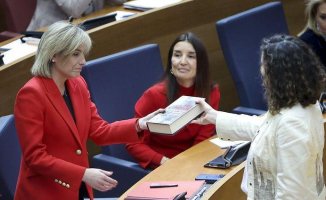As a child, in the modest neighborhood of St. Petersburg – former Leningrad – where he grew up, Vladimir Putin learned one thing: a cornered animal is dangerous, because it turns and attacks. He experienced it in person with a rat that he and his friends had chased around the neighborhood. He also learned that the strongest prevails in the street.
Some believe that the Russian president's threat to resort to nuclear weapons in the context of the Ukraine war is nothing more than bravado, a way of extorting fear from the West. But there are analysts who take them very seriously. And they fear that if Putin ever feels cornered, doomed to humiliating defeat or at risk of losing power, he could unleash a military escalation with potentially catastrophic effects.
The Kremlin chief's first warning in this regard was the announcement that he had ordered the Russian nuclear deterrence forces to be placed on alert. It was Sunday, February 27, four days after the invasion of Ukraine began, and his obvious goal was to stop any Western temptation for military action. Putin's decision was accompanied, before and after, by implicit but unequivocal threats of serious consequences – "never seen before" – in case NATO decided to intervene directly to the aid of Kyiv: "Those who threaten Russia must know that our reprisals will be quick as lightning; we have instruments for this that no one can even dream of and we will use them if necessary, ”he said.
Since then, and in the heat of Western sanctions and military aid to Ukraine, the rhetoric surrounding a possible nuclear confrontation has only increased in intensity and brashness. Russian Foreign Minister Sergei Lavrov has repeatedly alluded to the risk of a Third World War. And Russian television revels with astonishing levity on the subject, speculating on how long it would take for Russian nuclear warheads to reach major European capitals – about 200 seconds at most – or how long it would take to wipe the UK off the map.
The images broadcast by the Channel 1 television channel simulating the launch of missiles over London, Berlin and Paris, with their trajectory marked on a map of Europe, chillingly evoked those of the moment of the final conflagration in Stanley Kubrick's acid parody Dr. Strangelove (in Spain, ¿Red telephone?, We flew to Moscow), in which a crazed American general, Jack D. Ripper (played by Sterling Hayden), launched a preventive nuclear attack on the then Soviet Union. The 1964 film was released just two years after the Cuban missile crisis, which had brought the world to the brink of an atomic war between the United States and the USSR. But this time, in a real way.
The October 1962 crisis demonstrated the enormous danger that humanity was facing due to nuclear proliferation and strengthened the awareness that in an atomic confrontation no one could be the winner. From that time is the military doctrine of the Mutual Assured Destruction (MAD, acronym that in English means "crazy"), according to which the certainty of being annihilated in a nuclear war would guarantee that no one takes the initiative to use this type of weapon to attack the enemy. On this principle, the foundation of deterrence, the balance of terror was based during the cold war. Until now.
The Russians and the Americans began to seek ways to lessen the danger, and in the early 1970s they signed the first treaties to limit the development of new nuclear weapons and reduce their arsenals. But steps back have been taken in the last twenty years, amidst mutual accusations of non-compliance. Next week marks the 50th. anniversary of the signing of the ABM (Anti-Ballistic Missile) and SALT-1 (Strategic Arms Limitation Talks) treaties between Richard Nixon and Leonid Brezhnev, but there is little to celebrate. In 2002 George W. Bush decided to unilaterally abandon the ABM treaty and later more withdrawals have followed, on one side and the other, until reaching the withdrawal decided in 2019 by Donald Trump from the treaty on medium-range missiles (INF ) signed in 1987 by Ronald Reagan and Mikhail Gorbachev. The war in Ukraine has caught the two superpowers – with an arsenal of 5,550 atomic weapons in the case of the US and 6,255 in the case of Russia, according to the Stockholm International Peace Research Institute – at a time of serious loss of trust.
Could the situation in Ukraine, where Russia is facing strong resistance, push Putin to use tactical nuclear weapons? Could there be an escalation leading to a direct confrontation between Russia and NATO? The mere fact of asking such questions gives the measure of the seriousness of the moment. The first possibility has been judged plausible by the director of the CIA, William J. Burns, and the director of US National Intelligence, Avril Haines, who in the Senate expressed his conviction that the Russian president could resort to weapons nuclear weapons if he perceives an “existential threat” to his country or his regime. There are analysts who see it as highly unlikely. But not impossible. In an article published in Foreign Policy, Harvard professor Stephen M. Walt called for Russian threats to be taken very seriously. And he stressed: "Putin has a long history of warnings that he has later complied with."
4













